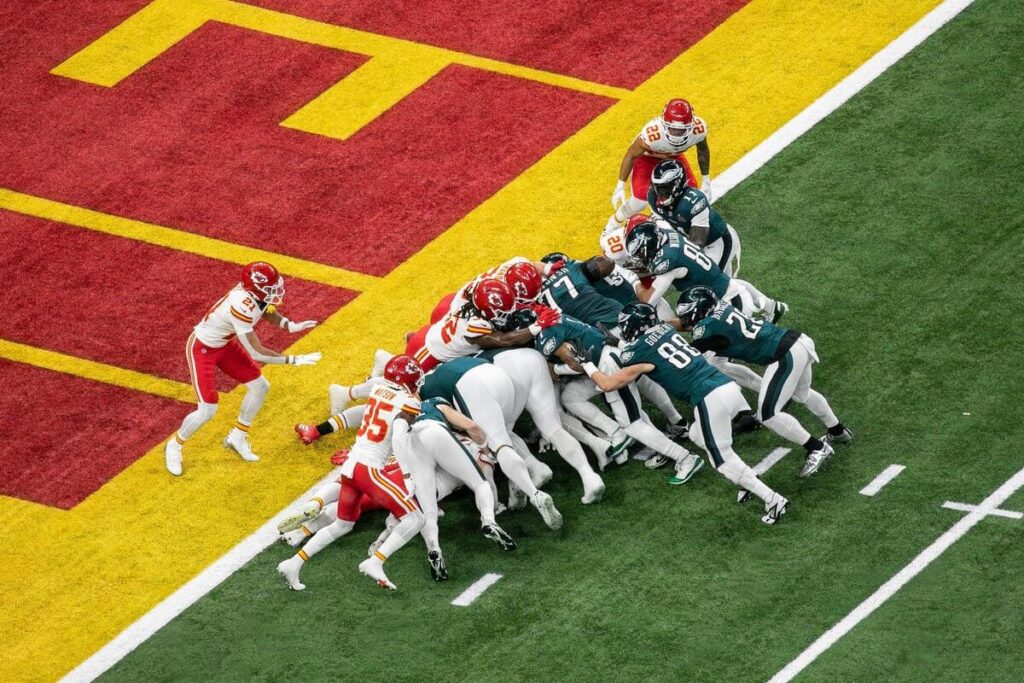every fall, NFL It’s back to dominating sports conversations across the United States — and increasingly around the world.
However, for those new to the league, its complex structure, endless statistics, and unique rules can feel intimidating.
From the basics of the game to the drama of the playoffs, here’s a full breakdown of how professional NFL football will operate in 2025.
The basics: How the game works
Each NFL contest lasts 60 minutes, divided into four 15-minute quarters. However, the actual experience is much longer – often approaching four hours – as half-time stops, replays, penalty kicks, and commercial breaks extend the running time.
If the teams are tied at the end of regulation, a 10-minute overtime period is played. Both teams get at least one opportunity to possess the ball unless the first team immediately scores a touchdown, in which case the game ends immediately.
If neither team can break the deadlock within those 10 minutes, the regular season game ends in a tie – although in the playoffs, overtime continues until a winner emerges.
The field itself is 100 yards long from goal line to goal line, with a 10-yard “end zone” at each end – the area where touchdowns are scored. Offensively, the goal is simple: move the ball down the field and outpace your opponent.
Teams have four attempts, called “touchdowns,” to gain 10 yards and reset their possession. If you fail to do so, the ball will change hands.
A touchdown, worth six points, is the most valuable result, with opportunities to add a point or two after that. Field goals are worth three points, while safeties — rare but dramatic — award two points to the defending team.
Playoffs: Where the real season begins
Once the regular season ends, attention turns to the playoffs — the NFL’s high-stakes knockout tournament that decides who makes it to the Super Bowl.
The current playoff structure was introduced in 2020 and remains in place through 2025. It expanded the postseason to include more teams and created an unpredictable path to glory.
How many teams will make it to the playoffs?


Fourteen teams qualify – seven from each conference, the AFC (American Football Conference) and the NFC (National Football Conference).
Each conference consists of four divisions, and the four winners automatically reserve their places in the playoffs. The remaining three spots in each conference are awarded to the teams with the best records that have not won their division – known as “wild card” teams.
Plant the difference
Seeding determines both matchups and home field advantage. The division champions are seeded first through fourth based on win-loss records, while the three wild-card participants fill out the fifth, sixth and seventh seeds in order from best to worst.
The top seed in each conference gets a deciding advantage — a first-round bye — meaning they skip the opening weekend and advance directly to the divisional round.
Wild card round
The postseason begins with the Wild Card Round, where the six remaining teams in each conference go head-to-head:
- The No. 2 seed faces the No. 7 seed
- The No. 3 seed plays the No. 6 seed
- The No. 4 seed meets the No. 5 seed
The higher-ranked team always hosts the game, rewarding consistency in the regular season. From here, each match is a single elimination – lose once, and your season is over.
Sectional and conference championships
The winners of the wild card weekend move on to the divisional round. The games are being restructured so that the lowest remaining seed in each conference faces the No. 1 seed, ensuring that the top teams benefit from their dominance in the regular season.
The other two winners play each other again in the court of the higher seed.
The victors of those contests qualify for the conference championships, one for the AFC and one for the NFC. These are among the most intense matchups in American sports, with the winners getting a ticket to the final stage – the Super Bowl.
Super Bowl
the Super Bowl It is more than just a football game. It is an American cultural phenomenon followed by hundreds of millions around the world.
It pits the AFC champion against the NFC champion at a pre-selected neutral venue. The winner receives the Vince Lombardi Trophy — and a permanent place in NFL history.
What happens if the teams are tied in the standings?
Given the NFL’s 18-week regular season, it’s not uncommon for teams to finish with identical records. To separate them, the league applies an elaborate series of intervals.
Within divisions, head-to-head results come first, followed by division record, performance against common opponents, and conference record.
If the teams still can’t be split, strength of schedule, points scored and other statistical factors are taken into account – and if all else fails, it comes down to the luck of the coin flip.
https://www.101greatgoals.com/wp-content/uploads/2025/07/NFL-Betting-Offers-Aug-9.jpg
Source link